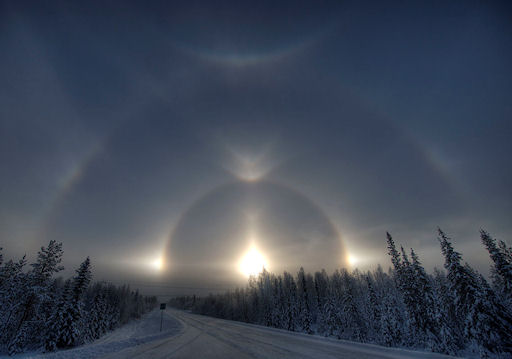AURORA ALERTS: Did you miss the Northern Lights? Next time get a wake-up call from Space Weather PHONE | | |
HALLOWEEN FLARES: After two days of quiet, big sunspot 1117 is once again crackling with solar flares. Magnetic fields around the active region became unstable on Oct. 31st, unleashing a C2-class flare at 0318 UT and a C6-class flare at 0431 UT. Movies: #1, #2.
AMAZING HALOES: Yesterday in Kittilä, Finland, photographer Sauli Koski witnessed a brief but unforgettable display when the rising sun shone through a morning cloud of wintery ice crystals. Fortunately he had his camera:

Full sized images: labeled or unlabeled
"These were the best ice haloes I have ever seen," says Koski. "They were there for only about 10 minutes and then gone. What a delight!"
"It was a gem of a halo display," agrees atmospheric optics expert Les Cowley. "Koski saw at least 13 different arcs. Some, including two types of Parry arc, are rare. Three more arcs, the helic, Parry supralateral arc, and Moilanen arc are exceedingly rare. See the key for the arc identities. With winter fast approaching, now is the time for outstanding halos."
A QUIET NIGHT IN NORWAY: Friday night's forecast called for little geomagnetic activity, but in northern Norway it only takes a little to produce a beautiful display. Helge Mortensen sends this Oct. 29th snapshot from the outskirts of Tromsø:

"The activity was very slow tonight, so the forecast was quite accurate," says Mortensen. "Nevertheless, a 15 second exposure with my Canon EOS 5D Mark II revealed the Northern Lights."
A more vivid display could appear on Nov. 1st when a solar wind stream is expected to brush past Earth's magnetic field. NOAA forecasters estimate a 30% chance of geomagnetic activity. High latitude sky watchers should remain alert for auroras.
October 2010 Aurora Gallery
[previous Octobers: 2009, 2008, 2007, 2006, 2004, 2003, 2002, 2001]
Potentially Hazardous Asteroids (
PHAs) are space rocks larger than approximately 100m that can come closer to Earth than 0.05 AU. None of the known PHAs is on a collision course with our planet, although astronomers are finding
new ones all the time.
On October 31, 2010 there were 1157 potentially hazardous asteroids.
Notes: LD means "Lunar Distance." 1 LD = 384,401 km, the distance between Earth and the Moon. 1 LD also equals 0.00256 AU. MAG is the visual magnitude of the asteroid on the date of closest approach. | | The official U.S. government space weather bureau |
| | The first place to look for information about sundogs, pillars, rainbows and related phenomena. |
| | Researchers call it a "Hubble for the sun." SDO is the most advanced solar observatory ever. |
| | 3D views of the sun from NASA's Solar and Terrestrial Relations Observatory |
| | Realtime and archival images of the Sun from SOHO. |
| | from the NOAA Space Environment Center |
| | the underlying science of space weather |

